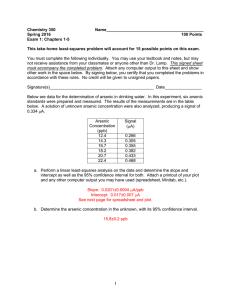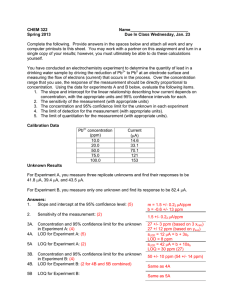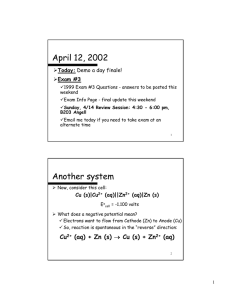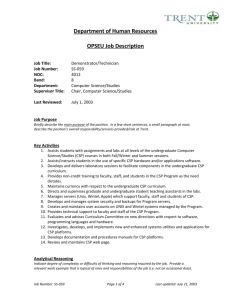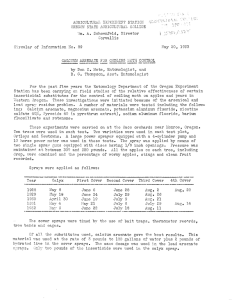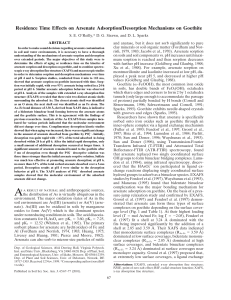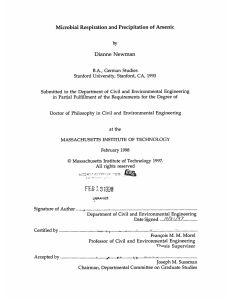Problem Set 4 –Figures of Merit, Calibration and Least... Complete all problems on separate paper. Show all work... significant figures is required for full credit. You can...
advertisement
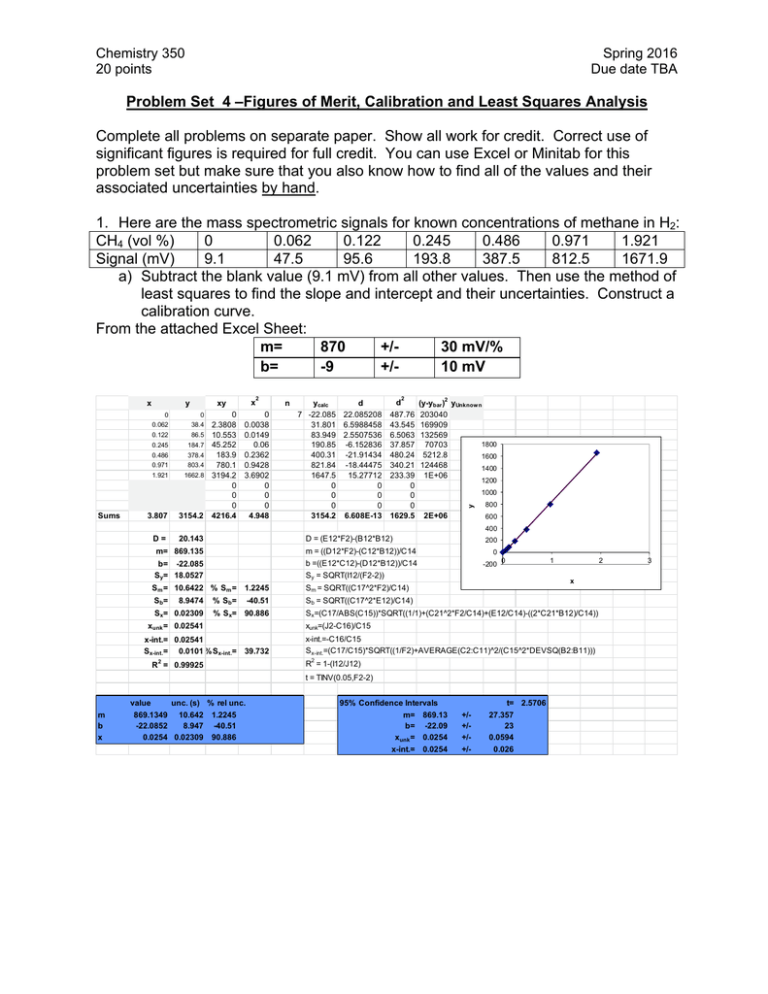
Chemistry 350 20 points Spring 2016 Due date TBA Problem Set 4 –Figures of Merit, Calibration and Least Squares Analysis Complete all problems on separate paper. Show all work for credit. Correct use of significant figures is required for full credit. You can use Excel or Minitab for this problem set but make sure that you also know how to find all of the values and their associated uncertainties by hand. 1. Here are the mass spectrometric signals for known concentrations of methane in H2: CH4 (vol %) 0 0.062 0.122 0.245 0.486 0.971 1.921 Signal (mV) 9.1 47.5 95.6 193.8 387.5 812.5 1671.9 a) Subtract the blank value (9.1 mV) from all other values. Then use the method of least squares to find the slope and intercept and their uncertainties. Construct a calibration curve. From the attached Excel Sheet: m= 870 +/30 mV/% b= -9 +/10 mV Sums y x xy 0 0 0.062 38.4 0.122 86.5 0.245 184.7 0.486 378.4 0.971 803.4 1.921 1662.8 3.807 3154.2 D= 20.143 0 2.3808 10.553 45.252 183.9 780.1 3194.2 0 0 0 4216.4 2 0 0.0038 0.0149 0.06 0.2362 0.9428 3.6902 0 0 0 4.948 n ycalc d 7 -22.085 22.085208 31.801 6.5988458 83.949 2.5507536 190.85 -6.152836 400.31 -21.91434 821.84 -18.44475 1647.5 15.27712 0 0 0 0 0 0 3154.2 6.608E-13 d 2 487.76 43.545 6.5063 37.857 480.24 340.21 233.39 0 0 0 1629.5 2 (y-ybar ) yUnknow n 203040 169909 132569 1800 70703 5212.8 1600 124468 1400 1E+06 1200 1000 y x 2E+06 800 600 400 D = (E12*F2)-(B12*B12) 200 m= 869.135 m = ((D12*F2)-(C12*B12))/C14 0 b= -22.085 Sy= 18.0527 b =((E12*C12)-(D12*B12))/C14 Sy = SQRT(I12/(F2-2)) -200 Sm = 10.6422 % Sm = 1.2245 Sm = SQRT((C17^2*F2)/C14) Sb= Sb = SQRT((C17^2*E12)/C14) 8.9474 Sx= 0.02309 % S b= -40.51 % Sx= 90.886 0 1 x Sx=(C17/ABS(C15))*SQRT((1/1)+(C21^2*F2/C14)+(E12/C14)-((2*C21*B12)/C14)) xunk=(J2-C16)/C15 xunk = 0.02541 x-int.= 0.02541 Sx-int.= 0.0101 % Sx-int.= 39.732 x-int.=-C16/C15 Sx-int.=(C17/C15)*SQRT((1/F2)+AVERAGE(C2:C11)^2/(C15^2*DEVSQ(B2:B11))) 2 2 R = 1-(I12/J12) R = 0.99925 t = TINV(0.05,F2-2) value m b x unc. (s) % rel unc. 869.1349 10.642 -22.0852 8.947 0.0254 0.02309 2 1.2245 -40.51 90.886 95% Confidence Intervals m= 869.13 b= -22.09 xunk = 0.0254 x-int.= 0.0254 t= 2.5706 +/+/+/+/- 27.357 23 0.0594 0.026 3 Chemistry 260 Chapter 1 – Introduction 2 b) Replicate measurements of an unknown gave 152.1, 154.9, 153.9, and 155.1 mV. Determine the concentration of the unknown and its uncertainty. Determine the 95% confidence interval for the unknown. To use our calibration curve, we must subtract the blank signal off first. Raw Signal 152.1 154.9 153.9 155.1 Corrected Signal 143.0 145.8 144.8 146 Vol % 0.189942 0.193164 0.192013 0.193394 Mean Stdev t CI 0.192128 % 0.001578 % 3.182446 0.00251 % So the confidence interval is 0.192 ±0.003 % c) A blank gave 8.2, 9.4, 10.6, 8.4, 9.6, 7.4 and 7.8 mV when measured multiple times. Determine the limit of detection at the 99% confidence level for the procedure. From these values, the standard deviation of the blank signal is 8.77 mV with a standard deviation of 1.13 mV. Therefore our signal at the detection limit is: 8.77mV + 3(1.13) = 12.17 mV Again, to use the calibration relationship, we need to subtract the blank signal (9.1 mV) from this value: 12.17-9.1 = 3.07 mV. Now we convert this to a concentration using the calibration relationship to find the LOD LOD = (3.07-(-20))mV/(870 mV/%) = 0.027% Chemistry 260 Chapter 1 – Introduction 3 2. Pure water containing no arsenic was spiked with 0.40 g arsenate/L. Seven replicate determinations gave 0.39, 0.40, 0.38, 0.41, 0.36, 0.35, and 0.39 g/L arsenic. Find the mean percent recovery of the spike and the detection limit for the method. %recovery g arsenate/L 0.39 97.5 0.4 100 0.38 95 0.41 102.5 0.36 90 0.35 87.5 0.39 97.5 Mean 0.382857 95.71429 Stdev 0.021381 5.345225 LOD 0.064143 The percent recovery is 100%x(Cspiked sample – Cunspiked sample)/Cadded. In our case Cunspiked sample = 0 g arsenate/L and Cadded = 0.40 g arsenate/L To find the LOD, we need the standard deviation of the measurements. Since they are already in concentration units and since we assume that a 0 g arsenate/L sample would give 0 concentration, our LOD is simply 3 times the standard deviaton of the sample concentrations. LOD = 3(0.021381 g arsenate/L) = 0.06 g arsenate/L 3. An unknown sample of Cu2+ gave an absorbance of 0.262 in an atomic absorption analysis. Then 1.00 mL of a solution containing 100.0 ppm (i.e. g/mL) Cu2+ was mixed with 95.0 mL of the unknown and the mixture was diluted to 100.0 mL in a volumetric flask with DI water. The absorbance of the new solution was 0.500. a. Denoting the initial, unknown concentration as [Cu2+]i, write an expression for the final concentration, [Cu2+]f, after dilution. Units of concentration are ppm. [Cu2+]f = (95 mL/100 mL)[Cu2+]i b. In a similar manner, write the final concentration of added standard Cu2+, designated as [S]f [S]f = (1 mL/100 mL)[S]I = (1/100)x100.0 ppm = 1.000 ppm c. Find [Cu2+]I in the unknown. 0.262 0.500 1.000 0.95 After some algebra, [Cu2+]i = 1.04 ppm Chemistry 260 Chapter 1 – Introduction 4 4. A constant volume standard addition experiment is performed. Five flasks containing 25.00 mL of a serum with unknown concentration of Na+ are labeled 1-5. Into each, varying volumes (see below) of 2.640 M NaCl standard is added. Each flask is then diluted to 50.00 mL. Flask 1 2 3 4 5 Volume of standard added (mL) 0 1.000 2.000 3.000 4.000 Na+ atomic emission signal (mV) 3.13 5.40 7.89 10.30 12.48 a. Use Excel or Minitab to prepare a standard addition graph and find the concentration of Na+ in the serum. volume concentration added added (mL) (M) 0 0 1 0.0528 2 0.1056 3 0.1584 4 0.2112 signal 3.13 5.4 7.89 10.3 12.48 From a least-squares analysis, we find the equation of our line to be: Signal in mV = 44.697mV/M(concentration) + 3.12mV Solving for the x-intercept (y=0) 0 mV = 44.697mV/M(concentration) + 3.12mV Concentration = -(-3.12mV/(44.697mV/M)) = 0.0698 M Since this was in the solution that was measured, we must account for dilution to determine the original concentration: 0.0698M(50.00mL/25.00mL) = 0.1396M b. Determine the uncertainty in the result. Here we need the sx-intercept, which from our least squared analysis is 0.00235 or 3.367%. So our uncertainty in the final concentration is 0.003367(0.1396M) = 0.0047M So our final result would be 0.140±0.005M, where we have estimated our uncertainty using the standard deviation. We could convert that to a confidence interval by multiplying by the appropriate t-value (t=3.1824 for 3 degrees of freedom)
